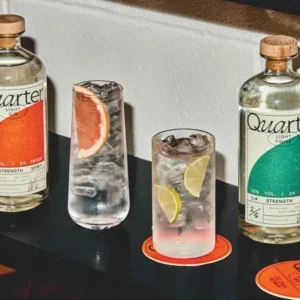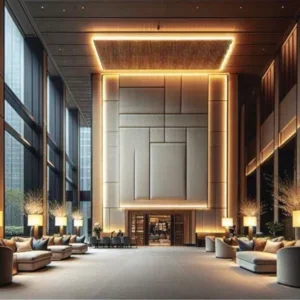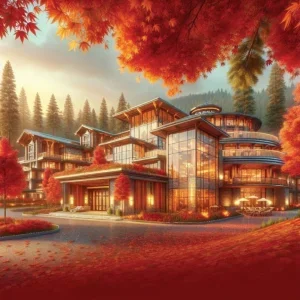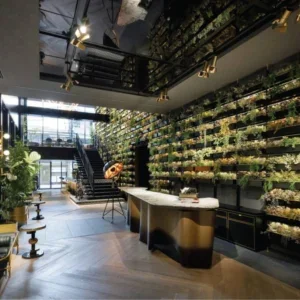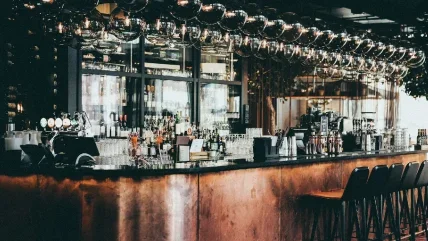
For much of the past century, the grandest hotels were synonymous with their drinking spots. From the American Bar at the Savoy in London(a favourite of Churchill and Hemingway) to Bemelmans at New York’s Carlyle (famed for its art deco gold-leaf ceiling ), boozers and bedrooms were enmeshed in the minds of punters and managers alike, as places oozing sophistication, where the conversation was serious and the drinks strong. Sometging of this sultriness was expressed by legendary baseball manager casey Stengel. “Don’t drink in the hotel bar,” he once warned his players. “That’s where I do my drinking.”
Yet, as the 1900s drew to a close, many hotel bars would find themselves emptying of sporting drunkards and most others. If nothing else, this is clear from the statistics, Spots like Bemelmans may once have been centres of the Big Apple’s cultural life. But as one 2010 survey by Zagat discovered, only 8% of New Yorkers frequented hotel bars on Friday or Saturday night, notably less than those who preferred pubs (9%), wine bars(11%) or restaurant bars(13%), or is this relative decline hard to understand. With standalone drinking spots now as varied as they are popular – in the UK, the number of so – called ‘Premium’ bars rose by 4.1% in 2019, even as pubs continued to close – there are now fewer reasons for thirsty guests to stick to the hotel lobby.
Operators, however, are clearly not insensitive to these changes. Aware of the deep heritage of many hotel bars, hotels are nonetheless refreshing what an evening at the bar involves. And mindful of living in a health-conscious age, one change involves the introduction of more non-alcoholic beverages. That’s shadowed by a more fundamental shift in tone. Where serious boozers like Casey Stengel may have been happy with low lights and strong whisky, gentler, more inclusive atmospheres are increasingly being normalised, accompanied by the usual assortment of pop-ups and sustainability efforts. Collectively, these shifts represent an essential change in what hotel bars can be – even if the old favourites are unlikely to ever disappear.
Bar to success
Few people have as much experience in hospitality as Scott Gingerich. A self-proclaimed “lifer” in the sector, he began his career as a busser back in 1990, and since then has done everything from running F&B operations at the Salt Lake City Olympics to managing Michelinstarred restaurants in Manhattan. In 2015, Gingerich made the jump to hotel hospitality, and now works as the Americas VP of restaurants and bars for IHG Luxury and Lifestyle. To put it differently, this is someone worth listening to – and right from the off, he’s eager to puncture one of the most basic clichés around hotel drinking holes. “Firstly, to be clear, we don’t consider our bars ‘hotel bars’ like we don’t consider our restaurants ‘hotel restaurants’ – as we have always gone to great lengths to create and operate restaurants and bars that stand on their own and are known as great entities unto themselves.”
Nor is Gingerich, now based in Florida, the only executive to make a similar claim. As Adam Crocini, senior vice-president and global head of food and beverage brands at Hilton, puts it, hotel bars are “pivotal to the brand” across his employer’s 7,000-odd properties. And certainly, it’s hard to disagree with these claims if you take even a cursory look at some of the most famous hotel bars the world over. From the Connaught Bar in London, all dark wood and grand furnishings, to the hip vibe at Jigger and Pony, the ever-popular haunt at the Amara Singapore, the best hotel drinking spots still have the power to conjure an instant sense of place, showing a site at its most attractive and showcasing its history in a glass.
Yet, with all their heritage, research like the 2010 Zagat survey sharply demonstrates the pressure hotel bars are under. Gingerich expresses this point in typically vivid terms, accepting that fewer of today’s guests would “tolerate the terribly mixed cocktail made by a grumpy bartender in a soulless lobby bar”. Beyond the general leap in competition, Gingerich suggests that the pandemic is to blame as well. With a postlockdown craze for social drinking, he notes that it’s recently been challenging to secure good bartenders, especially, perhaps, given cocktail recipes are now far more sophisticated than they were 40 years ago. Once again, moreover, the statistics seem to support this argument. US hospitality is still around two million workers short according to the US Bureau of Labor Statistics, while a joint survey by UKHospitality and the British Beer and Pub Association found that UK hospitality may have lost out on £21bn of revenue – in part due to a lack of qualified staff.
Something to celebrate
What can operators do to bolster the position of hotel bars? In the first place, it’s obvious that both IHG and Hilton are working hard to secure the most inventive bartenders in the business. Crocini, to give one example, highlights a range of recent hires at his employer, from Michele Montauti at the Waldorf Astoria Bangkok to Ana Martinez, the “tequila master” at Hilton Los Cabos. With new mixologists, it goes without saying, come new mixes. To an extent, that just involves finding clever ways of blending booze. In 2022, for instance, IHG developed a range of cocktails to mark the company’s 75th birthday. Celebrating the company’s Canadian roots, the ‘Canopy Fizz’ encompasses Labrador tea, local gin, absinthe – and a patriotic dash of maple syrup.
Not that every innovation needs to be alcoholic in nature. On the contrary, as a thoroughly global company, IHG is increasingly developing cocktails for non-drinking groups like Muslims. Another anniversary drink is a case in point: designed for the Intercontinental Ras Al Khaimah outside Dubai, the ‘Arabiana’ blends coconut, pineapple and dates. At the same time, operators are adapting to a broader cultural shift where tippling is less common than it used to be. “We’ve found that travellers across the globe are prioritising wellness more than ever,” says Crocini, “and that same sentiment has carried over to their drink order.” A fair point: in the US, to give one example, Gallup found that the number of student teetotalers has risen by 8% in only a decade. With this in mind, it’s unsurprising that both Hilton and IHG should be developing alcohol-free menus, with smoothies, boosters and adaptogens all making an appearance.
Dragging the menu away from alcohol equally gives managers opportunities to rethink the overall bar experience. Gingerich, for his part, suggests that zero-alcohol menus can help “foster inclusivity” at his watering holes, while Crocini notes that the ideal Hilton property “extends far beyond just the drinks themselves”. To this end, many operators are working to soften the atmosphere of their bars – often by simply dragging them away from high-ceilinged lobbies and ancient saloons. IHG is an excellent case study for this, with a basement storeroom becoming a speakeasy in Portland and an empty courtyard transforming into a winter-themed hangout in Southern California. European managers, for their part, are no less assiduous here. At The Hoxton in Southwark, for instance, this summer’s Oriole pop-up dovetails great drinks with innovative Spanish cooking. Not to be outdone, the Four Seasons in Madrid recently opened a patisserie in its El Patio lobby bar.
Raise a glass
Taken together, these innovations represent a major shift in what hotel bars can be. Nor are the most thoughtful operators stopping there. Exploiting the industry-wide push towards sustainability, IHG is introducing zero-waste programmes across some of its properties – which, apart from avoiding rubbish, also obliges bartenders to be even more thoughtful in how they meld limited ingredients. That’s echoed by related work beyond the hotel threshold. Partnering with a vineyard in the Languedoc, for example, IHG is now able to offer guests a range of biodynamic bottles. Taking it a step further, Gingerich adds, some bartenders are reviving classic drinks, or else developing new ones, by introducing unusual spirits. Once again, environmentalism is the key here – such as the Scottish brand that uses fruit scraps from food processing plants to make vermouth.
But, though the what, where and how of hotel bars are all changing fast, we shouldn’t count traditional establishments out just yet. “But that fancy lobby bar won’t go away either – perfectly positioned bars that allow all-day people-watching are still beckoning to belly up to the bar,” is how Gingerich phrases it, a sentiment Crocini wholeheartedly agrees with. As he puts it: “We think the expectation for hotel bars – especially ones considered ‘destinations’ in their own right – will continue to evolve.” Fair enough: it may be a jazz age holdout, but Bemelmans has lately enjoyed a glut of Gen-Z visitors, with queues to get tipsy now starting as early as 2pm. Casey Stengel would surely be proud.


